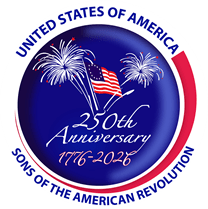America 250: Fort Henry Chapter Relocates and Restores Monument to McColloch’s Leap
Major Samuel McColloch’s “leap” is one of the most famous acts of pioneer heroism in the Upper Ohio Valley. On Saturday, October 28, 2023 a brief dedication ceremony was held to commemorate completion of the relocation and restoration of the monument to McColloch’s daring escape down the east side of Wheeling Hill during the 1777 siege of Fort Henry. The ceremony was the culmination of three years of planning and fundraising by the Fort Henry Chapter in Wheeling, West Virginia. The ribbon was cut by Compatriot Robert A. McColloch, great-great-great-great nephew of Major McColloch. The monument initiative is the chapter’s signature project to mark the forthcoming 250th anniversary of American independence in 2026.
In his remarks at the dedication chapter president Jay Frey acknowledged generous support from over 70 donors. Among the most significant contributors are the City of Wheeling, Ray and Dina Carney, the Elizabeth Stifel Kline Foundation, Rotary Club of Wheeling and the SAR’s George Washington Endowment. The Carneys were presented with the Silver Citizenship Medal from the West Virginia Society in recognition of their gift of the property for the monument’s new location. Frey also commended Savage Construction Co. for donating the flag pole and Top Notch Landscaping for covering the labor cost for landscaping the site. The names of donors at the $1,000 level and above are incised on the reverse of the new monument. The total cost of the project was $92,656.
To close the event, a musket salute was given by color guardsmen Larry Perkins (Ebenezer Zane Chapter, OHSSAR), Gary Timmons and Ron Malmgren (George Washington Chapter, PASSAR).
Notes
This year marks the 250th anniversary of the construction of Fort Henry in 1774. The effort was initially undertaken by Ebenezer Zane and John Caldwell in response to anticipated reprisal raids following the murder of Mingo leader Logan’s sister and brother at Yellow Creek. The fort was completed by militia under the command of Captain William Crawford and Colonel Angus McDonald from Fort Dunmore (formerly Fort Duquesne in Pittsburgh), with approval by Virginia’s royal governor, Lord Dunmore. Originally named Fort Fincastle, using Dunmore’s secondary title of Viscount Fincastle, it was renamed for his successor, Patrick Henry following Dunmore’s departure from Virginia during the Revolutionary War.
Submitted by James H. Frey, president, Fort Henry Chapter, WVSSAR





